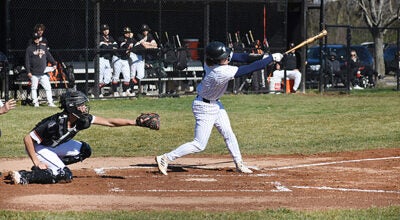Signal Point draws national recognition
Published 12:35 am Saturday, March 6, 2010

A look down the No. 8 fairway at Signal Point. (Daily Star photo/Provided)
By STEVE MORRISON
Niles Daily Star
Captured by arboretum of many species and bounded by U.S. 12, to the south; West River Road, to the west; and the St. Joseph River on the east lies a challenging gem for golfers of all calibers.
Signal Point Club, a private nine-hole course, was recently rated seventh out of the 25 best nine hole courses in America, by Ron Whitten in a Feb. 8 article for Golf World Magazine.
It is an honor for the community of Niles to have a local landmark again distinguished as a “one of a kind” keystone on the continent.
In 1964, Larry Plym, the patriarch of Kawneer Company, consulted with legendary golf course architect Robert Bruce Harris, then president of the American Society of Golf Course Architects to produce an 18-hole country club.
At that period of golf history, Harris was renowned for his craftsmanship in links development, along with Robert Trent Jones, Sr., Donald Ross and William Langford.
Realizing that the site on which Signal Point now exists was too small to accommodate an 18-hole course, Harris devised a plan to turn a nine -link club pasture into 18. Harris’ formula was to simply make each tee dual (except for the two par-threes) and to have each green have two holes.
In the first round, each player would hit from white tee to white flag, and, on the back nine, each golfer would play from a red tee to the red flag of each green, thus creating a multi-dimensional golf course with Plym’s desired 18 holes.
The first nine holes would measure a total of 3,044 yards and the concluding round would accumulate a distance of 3,181yards. The two nines would exhibit extremely different points of difficulty from each other. Thus Signal Point was born.
With its distinctive outlay, the challenge of the course is sometimes maddening. Thirteen beach-sized sand -traps near the greenside, two water hazards, and a bowling alley full of various trees test every golfer’s strength and imagination. Greens undulate in a delicate pattern, with lightning-like speed, often in the direction of the east-bound St. Joseph River. Just when one expects a putt to break or brake, one is often perplexed.
In spring, summer, or autumn, Signal Point features its multiple points of beauty. Well-manicured by superintendent Ken Fraser, Jr., it is a post-card picture of Michigan splendor. Flora and fauna complement well-manicured grounds.
The narrow, par three eighth/seventeenth hole is an opportunity to thread a needle through a haystack. At 171 yards long and, at its widest point, 25 yards across the oaks and pines loom as ominous threats from the tee. A huge kidney-shaped sand trap surrounds the entire left circumference of the green after threading the narrow aperture of fairway to green. If you are slightly short in distance, you are in the grains of sand; if your shot is too long, it lands in the beach or forest. Hook the pill, or slice it, and the sickening “thwack” of “tree-mendous” rejection pierces your ears.
Perhaps even more defying is the serpentine seventh/sixteenth segment. A double-dog leg, diabolical 435/489 yard endeavor requires a booming tee shot to the first corner, a well-placed iron 150 yards or so to the next bend, at the right, and a perfectly placed nine or wedge to the uphill green. No putt is a “gimme” on this domed green.
The fourth hole, a par-three 134 yard expedition, is no slouch either. Basically, the golfer must launch his tee shot from plateau one and land it safely on plateau number two. If you deposit the ball short, you’re in the valley. A little closer, and you’re in the gaping sand trap defending the front and right backside of the green. Too lengthy a shot places you in a dense jungle behind the green. The entire course is, indeed, a conquest waiting for the challenger.
Celebrities who have played the course include Gale Sayers, Wayne Gretzky. Lou Holtz enjoyed his tenure as a member, for several years, while coaching the Fighting Irish at Notre Dame.
Dale Campbell, course general manager since 2006, described all of the above history and tradition of Signal Point.
Campbell, born in Poplar Bluff, Missouri, graduated with a business degree from Central Methodist College in Fayette, Missouri. He played tennis in college and became a professional and instructor. Campbell formerly owned the Lakeland Athletic Club and still instructs tennis. His passion, as a golfer, is evident as well. At one point it was his second love; now it is evident as his first. Campbell is married, with three children, ages 6-11.
Dale’s father grew up across the street from golf legend Sam Snead’s home in Hot Springs, Virginia. As a boy, Dale’s father worked at the Homestead Resort, in Hot Springs course and became a life-long golf enthusiast. He passed his love of the game on to his son.
Campbell has truly enjoyed his tenure as the manager of Signal Point. He guessed that there have been only five or six previous managers prior to his supervision.
“We do hold some group outings with approval of our membership,” explained Campbell. “We love the exposure.”
Campbell described the subtlety of the greens as “very interesting.”
“The greens were very well done, very well thought out,’ he explained. This adds to the complexity of the contest.”You can putt on them all year and not have the same putt,” he added.
“Signal Point is very unique. It’s smaller; it’s a smaller membership (75). It’s quaint. It is a very comfortable place for the members and guests. To me it is just a unique club. It truly feels like a special place to work. I would say that to members and guests. It’s a special feeling as a member and a guest. As an employee, I feel that I am treated very kindly, by the members, and feel that it is a special place to work.”
Campbell, Fraser, chef Kelly Bishop and pro-shop manager Kathy Malone provide outstanding service and hospitality for a diamond in the rough.
Contact Campbell for further details at golfsignalpoint@comcast.net.
To view the complete article about Signal Point and the other top 25 nine -hole courses in America, in Golf World Magazine, go to GolfWorld.com…”Small Wonders…The 25 Best Nine-Hole Courses in America” written by Ron Whitten.






